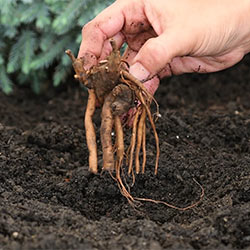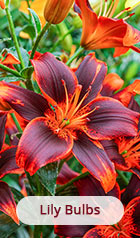
How to Grow and Care For Iris Plants
If you're looking to add a ton of color, and lots of reblooming power, you can't go wrong with irises. From tall German irises to delicate Japanese irises, there's something for every gardener and every garden among this pretty and celebrated genus. And, irises in all forms are relatively easy to care for!
What are Irises?
Irises are an incredibly varied genus of plants, including over 300 species. This much-loved genus actually includes two types of plants-those grown from bulbs, and those grown from rhizomes. Bulb irises include Dutch, English, Spanish, Reticulata, and Juno irises. The rhizome group includes bearded irises, crested irises, and beardless varieties such as the Japanese, Louisiana, and Siberian iris. The irises available through Michigan Bulb are quite hardy and easy to grow.
Most irises have ornate, showy flowers-in fact, the iris takes its name from the Greek goddess of the rainbow. Irises are a favorite of gardeners who love flowers in unique and rare colors, such as true blues and bright, vibrant oranges.
Iris Flower Forms
Irises grow in a variety of shapes and sizes, but there is something "iris-like" about each variety, especially when you compare their bright colors and soft petals.
Bearded Iris

Bearded iris plants offer a split, vertical form. These often have different colored standards (the top three petals of the plant) and falls (the bottom petals of the plant). They often feature soft hairs on the falls, giving them their "beardy" appearance. Bearded irises are some of the tallest plants in the garden, and work amazingly as standalone plantings or in the back of a bed.
Beardless Iris

Beardless irises, such as Siberian, Louisiana, and Japanese irises, have a flatter, butterfly-like appearance. Some offer draping, soft petals, and beardless irises tend not to grow as tall as their bearded counterparts. Beardless irises are usually able to withstand some shade, and can handle rich soil.
Crested Iris

Crested irises are usually dwarf irises, and feature a pretty collection of petals arranged in a circular sunburst. Crested varieties are perfect for planting in front of other, taller irises, or along any bed or border.
Dutch Iris

The most common type of bulb irises are called Dutch irises. Planted in the fall, these are a favorite in the U.S. and Europe, where they bloom in the spring alongside daffodils and tulips. These miniature iris plants are a favorite of florists, and also look beautiful in the front of beds and borders.
While these flowers are very different in appearance and size, they're all part of the same genus-and you're likely to see the resemblance. There is truly an iris for every landscape.
How to Plant Iris Bulbs and Rhizomes

Some varieties of iris are available as bulbs (bulb irises), others are available as bare root divisions (rhizome irises). Not sure if you have bulbs or rhizomes? Bulbs look like tiny, round packets, sort of like onions. Rhizomes are fleshy, clumped root systems. The planting process for bulb irises and rhizome irises is a bit different, but you'll find both to be relatively simple.
How to Plant Iris Bulbs
Dutch irises are the most common type of bulb-based iris. Planted in the fall, these are a favorite in the U.S. and Europe, where they bloom in the spring right along with daffodils and tulips. To plant your bulb irises:
- Find a planting location that experiences at least part sun or dappled sun throughout the day. Your planting location should also be well-drained.
- Work the soil before planting, and add compost or loam if you have hard or clay-heavy soil. These materials increase drainage and make for happier plants!
- Plant in mid fall, so that the bulbs have time to settle in before the harshest weather of winter.
- Plant your bulbs at about three times as deep as the bulbs are tall. Iris bulbs are small! If you have a one-inch-tall bulb, plant it about three inches deep.
- Backfill the holes, and mulch over the planting site before winter.
How to Plant Iris Rhizomes
Rhizome irises include delicate flowering plants, falling into three categories: bearded, beardless, and crested. As the names imply, these categories describe the shape of irises' unique flower heads. Japanese and Louisiana irises fall into the beardless category, and are popular perennials. To plant your iris rhizomes:
- Plant your rhizomes in a sunny spot in late summer. Even though these are rhizomatous plants, they'll appreciate an early start before winter.
- Sun needs depend upon variety, but most irises prefer full sun. Choose a sunny spot with great drainage for your iris plants.
- Dig up soil in your planting area, tilling the earth to about six to eight inches in depth. If your soil is clay-heavy, add in loam or compost to assist with drainage.
- Plant your rhizomes with their leaves face-up and their roots face-down. The rhizomes should be planted with their tops partially exposed and no more than an inch below the surface.
- Water in thoroughly, and add a low-nitrogen fertilizer to get your irises off to a great start.
For more information about planting iris bulbs, check out our blog to learn more about
iris planting techniques.
Caring for Iris Bulbs
Irises are a varied bunch, so the care requirements for these beloved flowers will depend on their type. However, there are several general rules for growing irises. After you've planted your irises, follow these tips to keep them happy and healthy.
- Watch for signs of root rot, such as stems tipping over or leaves falling off near the base of the plant. Avoid overwatering your irises, and don't mulch "up" around the stems.
- After your irises have bloomed, leave the foliage to yellow before cutting back the plants and removing them. Your plants need time to gather and store energy before the winter.
- Most iris plants are drought-friendly, but you should give them a good drink during dry spells. Aim to provide your irises with an inch of water per week during the hot, dry summer.
- Use a low-nitrogen fertilizer, or a balanced fertilizer, early in the growing season and again monthly.
- Irises don't require a ton of pest prevention, but you should watch for iris borers in the rhizomes. If you find rotted rhizomes, or ones with holes, dig up and dispose of the affected plants.
The biggest care issue facing irises? Dividing. Rhizomatous irises need to be divided every two to three years, and many bulb-grown irises can benefit from division, too.
How do You Divide Iris Plants?
Most irises grow from a thick, root-like structure, the rhizome, while some grow from true bulbs. Underground, the rhizome grows to create more leaves and more flowers. Just like other kinds of rhizome-grown plants, irises can become over-crowded, and their blooms can suffer a bit from having too much volume in one space. Luckily, dividing rhizomes is an easy task, and you likely will only need to do so every other year, or every third year.
- Divide your irises in late summer, after they've bloomed. Divide your irises before the weather begins to cool, in mid-autumn. Just add this chore to your other garden cleanup tasks!
- Dig up the roots of your iris.
Use a small spade or shovel to accomplish this task.
- Divide your irises.
Using a clean knife, cut the irises into new segments. They likely will break apart in your hands, making this task easy. If you're working with bulb irises, you'll find smaller bulbs, or bulblets, clinging to the sides of the parent bulb, and can pull those off.
- Replant your irises. Set them in the ground in the same way that you did when you first planted them! Place them in the same planting location, spread further apart. Or, place your iries in a new location in the landscape or share with fellow gardeners.
Healthy irises are quick growers, and you'll have a full planting space quickly. Dividing simply helps them to look lush.
What Are the Best Iris Bulb Varieties?
Irises are a true rainbow of a genus, blooming in so many shades, shapes, and textures that you'll simply never run out of ideas for gardening. While there's no one best iris, these are some of our favorites:
Charming Billy Siberian Iris

If you haven't tried Siberian iris, this is an easy, fast-spreading variety in a kaleidoscope of colors. The
Charming Billy Siberian Iris, in shades of purple, grows to a height less than two feet, with butterfly-shaped flowers and a charming disposition. Great for cut flowers!
Sheila Ann Iris

A tiny reticulata iris, the
Sheila Ann Iris grows to just under a foot tall, and produces a white flower with baby-blue edges. This is an excellent example of a bearded iris, and works wonderfully in the front of a flower bed.
Decadence Bearded Iris

You don't have to choose a finicky flower to have amazing color and unbelievable texture.
Decadence Bearded Iris does it all, with a combination of jewel-red and sun-yellow coloring. Perfect for direct sunlight spots and a wonderful way to add fluffy texture high above other flowers.
Good Omen Japanese Iris

Another soft, floating form, Japanese iris are a wonderful match for a rich, partially shaded spot in the garden. Try the
Good Omen Japanese Iris, with its huge flowers in a fanciful magenta.
Yaquina Blue German Iris

The
Yaquina Blue German Iris is a must have for a true-blue lover, this sapphire blue flower is a perfect German iris. Azure flowers stand tall in a grouping near a mailbox or fence.
No matter what type of landscape or aesthetic you're creating, irises are an easy, beautiful garden staple. Check out our
Iris category page page.to see more!
Have another question? Return to the Customer Service Help page or send an e-mail directly to Customer Service
































